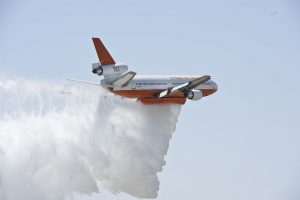 Not all airplanes are designed specifically to transport passengers and cargo from one place to another. Some of them are designed to extinguish fires. A profess known as aerial firefighting, it’s commonly used to prevent the spread of wildfires. If firefighters can’t easily reach a wildfire on the ground — or they lack the resources to extinguish it on the ground — they may use aerial firefighting airplanes. Below are five interesting facts about aerial firefighting.
Not all airplanes are designed specifically to transport passengers and cargo from one place to another. Some of them are designed to extinguish fires. A profess known as aerial firefighting, it’s commonly used to prevent the spread of wildfires. If firefighters can’t easily reach a wildfire on the ground — or they lack the resources to extinguish it on the ground — they may use aerial firefighting airplanes. Below are five interesting facts about aerial firefighting.
#1) Carry Up to 20,000 Gallons of Water
One of the main reasons why aerial firefighting airplanes are so effective is because they can carry a lot of water. There are different types of aerial firefighting airplanes, some of which can carry more water than others. The Boeing 747 Supertanker, however, is capable of carrying up to 20,000 gallons of water.
#2) Supports Fire Retardent
Aerial firefighting airplanes aren’t limited to water. They can carry fire retardant as well. Fire retardant is typically more effective at extinguishing fires, but it’s not always readily available. Therefore, firefighters will often use water. You can still find aerial firefighting airplanes that use fire retardent; it’s just not as common as water.
#3) Guided By a Lead Plane
Most aerial firefighting airplanes are guided by a separate airplane. Known as a lead plane, it typically flights in front of an aerial firefighting airplane while relaying directions to the pilot or pilots. Lead planes are also known as Supervision or Bird Dog airplanes. They act as the eyes for a given aerial firefighting airplane. The lead plane will scout out the wildfire from above, after which it will the pilot or pilots of the aerial firefighting airplane where to drop water or fire retardent.
#4) Refilling Without Landing
You might be surprised to learn that some aerial firefighting airplanes can refill their water storage tank without landing. It involves the pilot or pilots descending to the surface of a body of water, such as a lake. As the aerial firefighting airplane skims the body of water, it will pick up some of this water. The pilot or pilots can then ascend back to an appropriate altitude to continue on their firefighting mission.
#5) Owned by the National Guard and the US Marines
Both the U.S. National Guard and the U.S. Marines own fleets of aerial firefighting airplanes. During wildfire emergencies, government officials will often request the aerial firefighting services of these two military branches. With that said, there are privately owned aerial firefighting airplanes as well.



